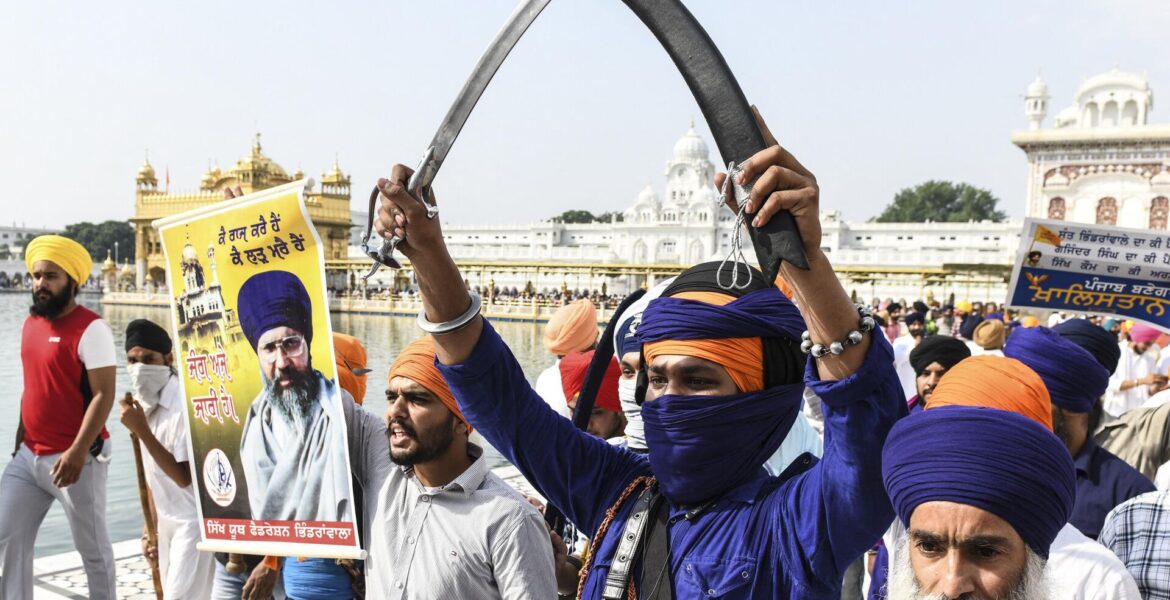This year has seen a marked resurgence in the Khalistan militant movement and the media reports have been consistently flooded with the news regarding the pro-Khalistan outfits creating situations of violence and disorder in not just India but overseas as well. As of recently, the National Investigation Agency (NIA) has taken matters into its own hands and carried out proactive investigations into several remote locations of Punjab and Haryana in order to crack down on the nexus of organised crime including activities of smuggling weapons across borders. What is very pertinent here to note is the relation of those arrested to the Khalistan Tiger Force (KTF) which has been at the forefront of this civic unrest being ensued in the name of establishing a separate Khalistan.
People like Arshdeep Singh, Manpreet Singh and their associate Gagandeep Singh have been arrested in the recent wave of crackdowns by the NIA and the search continues further. The Khalistan Tiger Force has definitely been one of the most significant organisations in bringing together the prominent pro-Khalistan militants and so it becomes all the more significant for the Indian state to carry out concentrated efforts to seize their operations, something that has been happening in full swing recently. So what is the Khalistan Tiger Force and what do we know about it so far?
The Khalistan Tiger Force came into existence in 2011 as an offshoot of the Babbr Khalsa International (BKI) militant group and has been described by the Ministry of Home Affairs as a “militant outfit which aims to revive terrorism in Punjab”. The organisation’s main aim is to develop violent campaigns for the creation of a separate Khalistan and hence compromise the territorial integrity of the Indian state. The organisation has also been officially designated as a ‘terrorist organisation’ under the 1st schedule of section 35 of the Unlawful Activities Prevention Act (UAPA) , 1967 and has been banned by the Indian state as of February 2023. Reports suggest that the organisation has been actively involved in carrying out armed attacks and explosions in Punjab and target political figures in the region such as in the case of the killing of the Punjab Chief Minister Beant Singh in 1995. Many individual members of the organisation have been separately charged with cases of inciting terrorism and separatist tendencies in the region.
Some key figures of the organisation include UK based Paramjit Singh based in Birmingham, Baljeet Singh Gill based in London, Sarabjit Singh residing in London, and Sarabjit Singh Banur based in London as well as US based Kulwant Singh, France based Parshotam Singh Pamma and Spain based Jaswinder Singh. Other figures such as Jagtar Singh Tara had been previously charged with the killing of the then Punjab chief minister in 1995, it was in 2015 that he was arrested in Thailand. One thing very prominent in tracing the cases of these individuals is the transnational character of their activities.
Arshdeep Singh Gill, who has been recently designated as a ‘terrorist’ by the Indian government, has been basing his operations in Canada. He has been actively involved in cases related to targeted killings, terror financing, extortion in Punjab as well as cross-border smuggling of drugs and weapons. Extortion and smuggling of arms and ammunition across the border have been the primary activities contributing to the financing of operations of the KTF over time.
It has also been reported that the KTF militants have links with Germany and Thailand. Jagtar Singh Tara, who himself had set up a base in Thailand had revealed in his interrogations that he had ordered a glider from Germany in order to carry out airstrikes in Punjab’s Pathankot in alliance with Pakistan’s prominent terrorist organisation Lashkar-e-Taiba. This is the cue to also bring in the angle of cooperation with terrorist outfits in Pakistan and even Pakistan’s intelligence agency, Inter-Services Intelligence (ISI). Claims have been made that the ISI has been seeking to form a collaboration with the militants in Punjab by providing them with necessary arms and ammunition in order to keep alive the separatist agenda in India’s Punjab. It was also earlier this year that the Indian Ministry of Home Affairs declared Harwinder Singh Sandhu as a ‘terrorist’. It is to be noted that Harwinder Singh Sandhu has been the mastermind and prime actor in the 2021 attack on the headquarters of Punjab Police in Mohali and since then he had been setting up camp in Pakistan under fake passports. Reports suggest that he had conspired together with the pro-Khalistan militant outfits back in Pakistan and was hence provided a security cover with them.
The entry of the Khalistan Tiger Force into the 1st schedule of the Unlawful Activities (Prevention) Act has brought the total number of terrorist organisations up to 44. Out of these around five militant organisations are explicitly related to the issue of Khalistan. The KTF, just like the other such groups- Babbar Khalsa International, Khalistan Zindabad Force or International Sikh Youth Federation has been actively involved in spewing venom against the next generation of Sikh youth, both in India and in the international diaspora. The evidence and reports suggest their transnational links which further adds to the risk factor posed by these outfits. However, the proactive measures in declaring the organisation as a ‘terrorist organisation’ as well as individually targeting the members who have been involved in militant activities over the years and labelling them as official terrorists, does serve to crackdown on these organisations efficiently in order to protect the integrity and national security of the Indian state.

